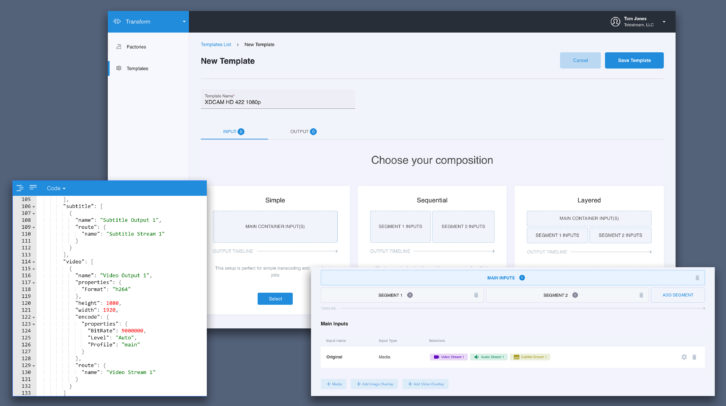The broadcast industry is notable for several things, a major one being that new technology adoption typically comes with a transition phase. Today, this is evident in the transition from SDI to IP and from on-prem, server-based media processing to using cloud-native services for that purpose. The cloud transition must consider the driving factors enabling the transition, the massive size of media files, mandatory reliability and high quality, and it must consider the fact that media companies do not, and in many cases, cannot be tied to a single cloud provider.
Focusing on the transition to cloud, there are several factors providing the impetus to make the move. First, the acceptance and adoption of cloud infrastructure is becoming more prevalent. There is a mindset change underway from owning and managing a private data centre to adoption of cloud services for storage and management of media content.
Second, cloud-based services are widely available for many applications, which means there is less concern about them for use in the media and entertainment industry. The unfamiliar can often be rejected out of hand for just that reason – it’s different from the “norm”. As cloud adoption becomes more ubiquitous there is a need to have cloud-native software services available to execute media workflows. This is where media companies are going and having access to deployment options is the best way for them to facilitate a transition.
Third, and this has long been true going back to the origin of cloud-native services, elasticity (the ability to set resource limits based on demand fluctuation) and scalability (the ability to expand and contract resources in lock step with demand fluctuation) ideally suits the requirements for media processing engineering and operations. Media companies can control their costs by limiting capacity (and changing those limits over time) and stretching out timelines, or they can scale up to peak demand for maximum throughput and continue to match resources to demand. There is no need to overbuild media processing capacity when utilising elastic cloud resources.
Fourth, as the decentralisation of workers accelerates, native cloud media services allow remote workforces to more easily collaborate and not rely on hardware and locally installed software.
Fifth, change is occurring with respect to the operations of the media companies. More and more there is core competency in software development and a desire by those groups to be flexible in the deployment of their workflows. These development teams want to control the decision making and technology integration themselves without relying on their suppliers’ road maps.
Data gravity
Massive media files require processing where the data resides, and movement of this content needs to be minimised or eliminated altogether. If it resides in the cloud or is destined for storage and distribution in the cloud, then it should be processed in the cloud. This is “data gravity” where the processing is brought to the media and not the other way around. Thus, moving massive media files can be eliminated.
At Telestream, we have been focused on harnessing the power and versatility of cloud-based data processing for some considerable time. Bringing the Telestream Media Framework to the cloud allows for continuity for our customers workflows by using an underlying technology they can trust.
What is the Telestream Media Framework? For decades, Telestream has been developing the workflow and transcoding technologies used by media and entertainment companies worldwide. The Telestream Media Framework is what sits behind our Vantage Media Processing Platform, Vantage Cloud Port and now, the Telestream Cloud Transform service.
We see a need to create cloud-based systems that feel and look familiar to operators and immediately create confidence that this new way of working is an evolutionary development rather than a leap of faith.

As remote working becomes more popular, cloud SaaS products allow decentralised workforces to more easily collaborate and not rely on hardware and locally installed software. Furthermore, there has been a change in who manages the operations of the media companies. More and more, there is core competency in software development and Telestream’s Transform service, as an API-first software product allows those groups to be flexible in their deployment of their workflows. Building on this trend, Telestream has created a new cloud-based media engineering service that exploits this new way of working.
Why is a cloud agnostic approach important?
Telestream is one of a small group of companies that are cloud agnostic. Our customers can choose to use any cloud partner they prefer, and we are able to meet them there. Some of the other transcoding services in the market lock customers into their cloud infrastructure and do not offer a choice.
So, what can customers do now that they could not do before? Transform is a cloud service that allows developers to work on their applications, and not spend years learning the intricacies of the countless video formats in use worldwide. Through its API, development teams can write JSON compositions to manipulate media without ever worrying about what is under the hood. This means that they design the processing workflow that works for their organisation and Transform manipulates media and puts the assets where the organisation needs them. Other technology solutions are not able to provide the breadth of transcoding and media processing capability that is available in Transform with the Telestream Media Framework.
However, we are not taking the ‘Model T Ford’ approach to this where you can have it in any colour, so long as it is black. We need to build flexibility into our customer resources. Another approach – Vantage with Vantage Cloud Port is best for customers who need visualisation tools to build workflows (what we call, “Workflow Designer”), and they need to have decision-making built into those workflows.
Transform is for customers who have a development team that wants access to Telestream media processing capabilities, and they plan to build their workflows outside of the service. There are no visualisation tools in Transform, and there is no decision-making capability either. Both Transform and Vantage Cloud Port are built on the Telestream Media Framework.
The past 18 months will transform the M&E sector in the long term. The global pandemic has changed the way we work, and that change will probably last much longer than the pandemic. At the same time, the increasing influence of cloud-based operations dovetails with this trend to help support talented and creative executives to work where and how they wish. We are on the cusp of another technology revolution in the broadcast operations – to date it has been a quiet revolution, but we think that is about to change – watch this space.







